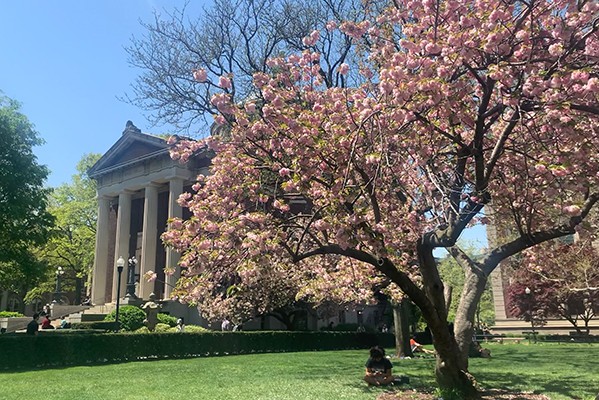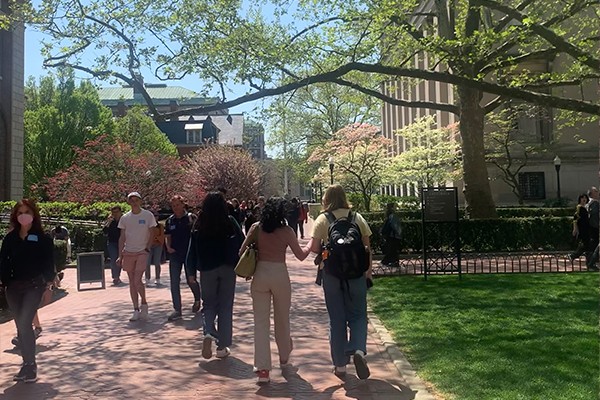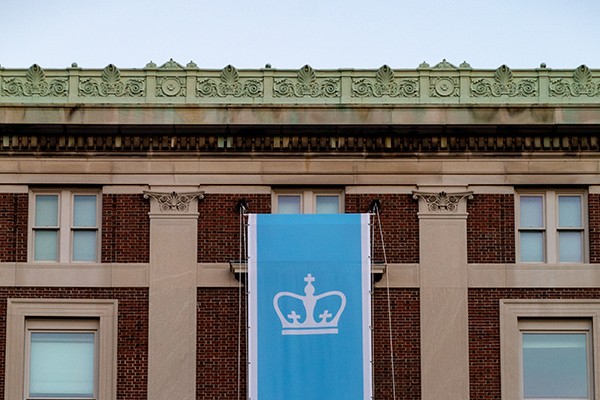Overview
The Department of Biological Sciences was formed in 1966 through the merger of two previous departments, Zoology and Botany. The Zoology Department had a very distinguished history. Thomas Hunt Morgan, Edmund Beecher Wilson, and Theodosius Dobzhansky, extraordinary pioneers in genetics, cell biology, and evolutionary biology, respectively, were leading faculty who did their seminal work at Columbia from the 1900s to the 1940s. Cyrus Levinthal was recruited from MIT in 1968 with a mission to further build up biology at Columbia. The initial focus for the Department was on molecular biology and neurobiology, two areas that remain at the forefront of modern biology. The Department expanded into additional research areas over the past two decades, such as developmental biology, cell biology, structural biology, biophysics, chemical biology, and computational biology. Our faculty members have received many honors and awards, an indication of the strength of the Department. We count among our faculty two Nobel Laureates (Chalfie, Frank), a Benjamin Franklin Medalist (Frank), six members of both the National Academy of Sciences and American Academy of Arts and Sciences (Chalfie, Frank, Greenwald, Manley, Prives, Przeworksi), two National Academy of Medicine members (Chalfie, Prives), two NIH Director’s Pioneer Award winners (Tavazoie, Yuste), and four Guggenheim Fellowship winners (Bussemaker, Firestein, Landweber, Pollack).
The Early Days
In the crisp fall days of early October 1892, a series of lectures were delivered in Columbia’s old School of Mines building on 49th St., inaugurating the Department of Zoology. Darwin’s theory of evolution had been hotly debated at Oxford just a few decades earlier, Gregor Mendel’s theory of inheritance was about to be rediscovered, and microscopes and methods of tissue staining were being perfected —the time was ripe for the scientific revolution.
“The Department of Biological Sciences faculty and students have been awarded 11 Nobel Prizes."
In the late 19th century, the nascent department consisted of brilliant researchers and naturalists in the fullest sense of the word, such as Bashford Dean and Edmund B. Wilson, who did fundamental work in vertebrate anatomy, taxonomy, and paleontology. Early on, they forged collaborations with the new American Museum of Natural History, fostering the mutual growth of both institutions and laying the foundation for future collaborations around the US and the world. Dean was a founder and the first Director of Cold Spring Harbor Laboratory, and by the mid-1890s many Columbia investigators spent summer months doing research there and at the Marine Biological Laboratory at Woods Hole, as well as the Naples Marine Biology Station in Italy. Nathaniel Lord Britton, a professor of botany and geology, and his wife, Elizabeth Knight Britton, a botanist and respected scholar of mosses, helped create The New York Botanical Garden—many of the original specimens came from university collections. Soon after the turn of the century, zoologist and primatologist William K. Gregory famously categorized early humans into four types—Pithecanthropus, Neanderthal, Piltdown (based on bones later shown to be another man’s clever composite forgeries), and Cro-Magnon. Women joined the department as graduate students enrolled at Barnard College as early as 1904, and by 1912 researchers such as Florence de L. Lowther and Grace S. Forbes were teaching invertebrate and vertebrate zoology.
It was in Naples that E.B. Wilson met Thomas Hunt Morgan, a meeting that would spark perhaps the most luminous period in the department’s early history. As historian of science, Dr. Charles Galperin writes, “We have here the work of a cytologist and embryologist, coinciding with the most brilliant period of cytology and embryology in Europe during the last quarter of the 19th century.” Wilson—whose scientific lineage led from A.E. Verrill back to Agassiz straight to Cuvier, the founder of comparative morphology and vertebrate paleontology—had already begun the ambitious task of collecting the entirety of contemporary knowledge on cellular morphology and division, as well as development and heredity, into the lectures he gave at Columbia in 1892 and 1893. These lectures would form the basis for the remarkable book first published as Cell in Development and Inheritance and which we know today simply as Cell, a colossal work of science attuned to shifting theoretical contributions that make it, as Galperin writes, “both a scientific monument and an essay in the history of science.” In 1904, Wilson brought Morgan to Columbia as the first Chair of Experimental Zoology, and Morgan’s studies with Drosophila revealed fundamental principles of genetics, paving the way for modern genetic analysis. The revolution had arrived. Morgan’s students and collaborators, including Calvin Bridges, Alfred Sturtevant, and Theodosius Dobzhansky would go on to do pioneering work in genetics and molecular biology—Bridges discovered definitive proof of the chromosome theory of heredity and Sturtevant constructed the first chromosome map of gene locations as Columbia College undergraduates. Dobshansky married genetics to evolution to create the “Modern Synthesis,” an influential template for future research.
As Wilson presciently wrote for the Columbia University Quarterly on the occasion of Morgan’s arrival at Columbia: “Agassiz used to estimate the value of zoological work largely by the extent to which was comparative rather than descriptive. Its future value is certain to be measured largely by the standard of the experiment.” The following decades and discoveries in the biological sciences at the university proved him correct. J. Herbert Taylor’s pioneering use of autoradiography to study DNA replication in plants led to the generalization of new insights from studies of nucleic acids in bacteria and viruses; the use of electron microscopy to study cell structure, pioneered at Columbia, was combined with physiology by Lee Peachy to gain understanding of the functional organization of striated tissue; and Selig Hecht’s photochemistry experiments in clams and insects led to groundbreaking research on vision, including dark adaptation, color vision, and the mechanism of the visual threshold. By the 1940s, Columbia had been firmly established as one of the world’s preeminent universities for the study of biological questions.

Mid-Century Expansion
In 1966, the Zoology and Botany departments were merged, creating the modern Department of Biological Sciences. The following year Cyrus Levinthal was recruited from MIT to oversee the new department and by the early 70s, an ambitious plan for focused expansion targeted a few key areas: genetics, molecular biology, cell biology, and developmental neurobiology. In the decades that followed, the lines between cell biology and molecular biology began to blur, and the introduction of computers changed the way science was being done in every field of inquiry.
Levinthal had started applying computers to protein structure at MIT, where he had already made important discoveries in molecular genetics, including mechanisms of DNA replication, the relationship between genes and proteins, and the nature of mRNA, work he continued and built upon at Columbia. He was the first to measure the size of the genome in a virus and described the Levinthal number (also known as Levinthal’s Paradox), or how long it would take a protein to fold given all possible combinations. Crucially, he pioneered the application of computers to 3D-imaging of folded protein structures and to the monumental task of mapping the nervous system. His visualization efforts continued until his death in 1990 and laid the foundations for current research.
Levinthal recruited top researchers to the new Biological Sciences department, shaping its character and direction. James Darnell made seminal discoveries about the processing and synthesis of RNA and later served as Vice President for Academic Affairs at Rockefeller University. Barbara Filner, who studied the biochemical responses of plants to gravity and light, was a tireless supporter of women in science who would go on to become Director of Health Sciences Policy at the Institute of Medicine. John Hildebrand used the giant sphinx moth, Manduca sexta, to uncover how sensory axons interacting with targets in the brain can change an organism’s behavior in profound and unexpected ways. Eric Holtzman, a beloved teacher and researcher, made significant contributions in several major areas: how membranes function in nerve cells; how lysosomes break down harmful substances within cells; how cells manufacture proteins, and how cell markers trace intracellular protein movements. One of Levinthal’s postdoctoral students, Eduardo Macagno, joined the faculty to investigate cellular and molecular mechanisms underlying the specification of neuronal identity and connectivity. He went on to serve as Dean of the Graduate School of Arts and Sciences from 1993 to 2000. Lawrence Chasin, one of the current department’s longest-standing members, joined the faculty during this vibrant period and pioneered the use of computational methods to address key questions about control of gene expression and RNA splicing.

In 1980s and early 1990s, several outstanding researchers were recruited, including Darcy Kelly, who has advanced understanding of the neural mechanisms of social communication, Jim Manley, whose has made significant contributions in the area of gene expression—particularly transcription initiation of mRNA encoding genes, mRNA splicing, and mRNA polyadenylation—and Carol Prives, whose seminal work on the p53 tumor suppressor gene has offered crucial insight into the pathway most frequently involved in cancer. Mu-ming Poo did seminal work on axonal guidance, Alexander Tzagoloff has offered insights into the propagation of mitochondria, and Tulle Hazelrigg has helped elucidate the mechanism of subcellular RNA localization, required for morphogenesis in many types of cells. Michael Levine did ground-breaking work on transcriptional control of Drosophila development, following in Morgan’s footsteps. In the same era, Martin Chalfie pioneered the use of the nematode Caenorhabditis elegans to investigate aspects of nerve cell development and function, particularly sensory receptors for touch.
In the 1990s the department expanded further, with a specific focus on neuroscience and structural biology. Researchers including Michael Sheetz, Stuart Firestein, and Rafael Yuste joined the department and have done groundbreaking work in unraveling neural mechanisms and processes, including work on motor proteins that contract muscles and enable cellular movement, the mechanisms of olfaction, and the function of the cortical microcircuit, respectively. John Hunt and Liang Tong brought new structural methods of inquiry to bear on fundamental biological questions, specifically the structural and thermodynamic mechanisms by which proteins perform mechanical activities on a molecular scale and the mechanism and function of biological macromolecules. As the department continued to grow, many of the researchers now working under the aegis of Biological Sciences forged rich connections to many other departments and fields: Fernandez to Physics; Sheetz to Engineering; Stockwell to Chemistry; Yuste to chemistry and neuroscience. Researchers including Harmen Bussemaker and Dana Pe’er pioneered computational approaches to take advantage of the ever-growing data sets becoming available to researchers around the world. By the turn of 21st century, the Department of Biological Sciences was an interdisciplinary powerhouse with a robust and growing network of intellectual resources stretching across the university and beyond.

Today, the department includes over 100 PhD students and provides post-doctoral training to 40-50 promising young researchers every year. Our world-class faculty includes five members of the National Academy of Sciences, five members of the American Academy of Arts and Sciences, and two Nobel Prize winners: Martin Chalfie was awarded the 2008 Nobel Prize in Chemistry for his introduction of green fluorescent protein (GFP) as a biological marker, and Joachim Frank was awarded the 2017 Nobel Prize in Chemistry for his work in Cryo-Electron Microscopy. Michael Sheetz was awarded the 2012 Lasker Award in Basic Biomedical Science. We count among our ranks two members of the National Institute of Medicine (previously the IOM), six American Association for the Advancement of Science fellows, three HHMI-funded labs, an HHMI Professor, and two NIH Director’s Pioneer Award winners. In addition, Rafael Yuste is a member of the NIH BRAIN Initiative advisory working group, and played a major role in launching the project. Joachim Frank was awarded the Benjamin Franklin Medal in Life Science in 2014. With a rather fitting nod to the department's history, in 2010 Alex Tzagoloff received the Thomas Hunt Morgan Medal from the Genetic Society of America. The Department continues to foster innovation in teaching through the efforts of Deborah Mowshowtiz—who received the Presidential Outstanding Teaching Award in 1999—and other faculty members, including five who have received Columbia Distinguished Faculty Awards. Fifty years after it was first founded, the Department of Biological Sciences continues to foster remarkable students and researchers.
Looking Toward the Future
Faculty members recruited over the past forty years continue working at the forefront of fields such as cell and molecular biology, neuroscience, developmental biology, structural biology, biophysics, and computational biology. Now, a new generation of researchers has arrived to carry the torch of investigation and discovery into the 21st century. Molly Przeworski is using massive data sets to study the dynamics of adaptation and the determinants of recombination and mutation in humans and other species. Guy Sella works to understand natural selection at the level of the genome, using quantitative models to distinguish patterns of genetic variation and make inferences about the relationships between genetic variation and natural selection. Iva Greenwald is studying how LIN-12/Notch signaling is modulated during normal development and how its modulation could potentially be used to combat disease. Oliver Hobert is unraveling the gene regulatory control mechanisms that generate the astounding diversity of cell types in the nervous system. Ozgur Sahin, who recently received the NIH Director’s Innovator Award and a Packard Fellowship, is investigating biological systems that function under physical extremes like short timescales and high mechanical forces, and how insights gleaned from these systems can be applied to medical, environmental, and energy-related problems.
Many of the newest faculty to join the department are conducting research related to neuroscience. Erin Barnhart focuses on the cell biology of the neuron to explore how neurons and circuits balance functional requirements with energetic constraints in vivo. Maria-Antoinetta Tosches studies the evolution of cell types and circuits in the vertebrate brain, taking an evolutionary approach to unveil general principles of brain organization and function in vertebrates. Raju Tomer has done groundbreaking work in mapping brain structure and function, harnessing the power of computational biology to develop and apply molecular, optical and data analytic methods for multi-scale understanding of complex biological systems. Laura Duvall studies neuropeptides and the regulation of innate behavior in blood-feeding arthropods, such as mosquitoes, which have emerged as potent vectors for disease in an age of climate change.

In addition, three new faculty are doing cutting-edge research in the areas of molecular and cellular biology. Jellert Gaublomme works to create and apply multi-omic technologies to study biomolecular and cellular interactions during development and in pathological conditions. Marko Jovanovic seeks to understand the principles and mechanisms by which translational regulation controls the dynamics of gene expression and therefore affects processes like differentiation, stress responses and pathogenesis. Saeed Tavazoie focuses on how cells adapt to changes in their external environment, studying this inherently systems-level phenomenon across a range of timescales, from rapid transcriptional responses, to multi-generational epigenetic reprogramming, to long-term rewiring of signaling and regulatory networks over evolutionary timescales.
In the area of evolutionary biology, Peter Andoffatto recently joined the faculty and is studying the processes that shape genome evolution and the genetic mechanisms underlying adaptations. His lab brings together aspects of molecular genetics, biochemistry, ecology, genomics and computational biology to study the factors that limit the rate of adaptive evolutionary change and the extent to which the genetic basis of organismal phenotypic diversity is predictable.
Simon Tavare, computational biology researcher and director of the new Irving Institute for Cancer Dynamics, has also recently joined the faculty of Biological Sciences. His work focuses on the quantitative and technological underpinnings of cancer research, including how mathematical and statistical methods developed to understand the behavior of gene frequencies in populations can be exploited to study aspects of cancer evolution, particularly tumor heterogeneity.
These and the many other researchers, postdoctoral scholars, and students who make up the Biological Sciences department today are once again expanding the scope and shifting the focus of the department, paving the way for the fundamental discoveries and scientific revolutions for the next century.
